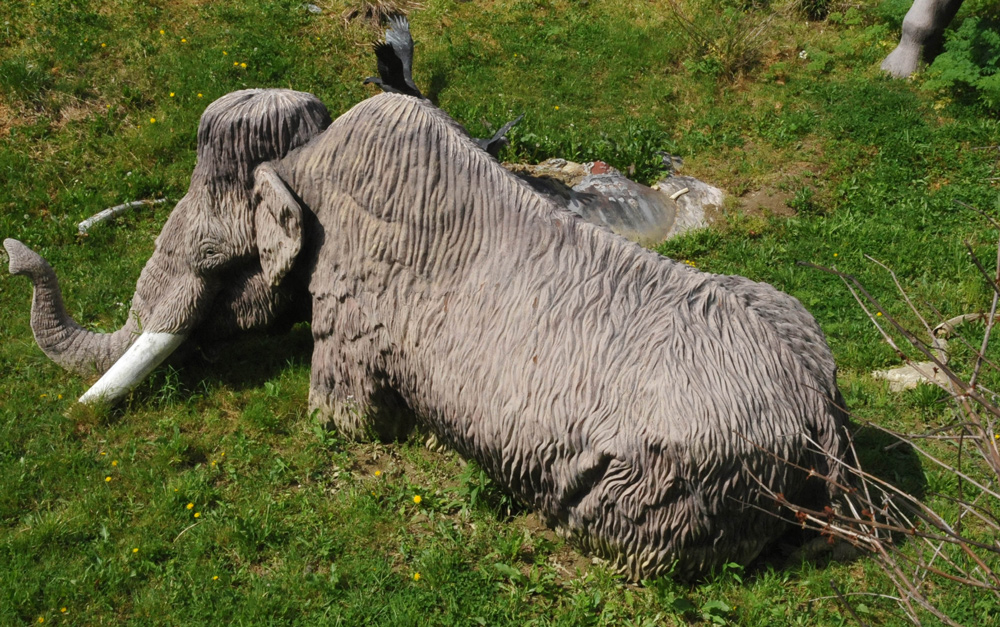Lewis is likely at Big Bone Lick collecting fossil bones and fellow travelers Thomas Rodney and Nicholas Cresswell describe the diggings that he saw.
In Washington City, Henry Dearborn of the War Department asks General Wilkinson to have the U.S. Army ready for Spanish opposition to the Louisiana Purchase.
Woolly Mammoth Display
Big Bone Lick State Park
By Jerrye & Roy Klotz, MD. Permission via the Creative Commons Attribution-Share Alike 3.0 Unported license.
Today, visitors still come to Big Bone Lick, now a Kentucky state park. Big Bone Lick State Park is a Lewis and Clark Heritage Trail Site so designated by the U.S. National Park Service in 2002. The park is also listed on the National Register of Historic Places and was designated as a National Natural Landmark in February 2009.[1]Big Bone Lick State Park, https://en.wikipedia.org/wiki/Big_Bone_Lick_State_Park, accessed on 6 January 2019. Lewis didn’t expect to see a live woolly mammoth or mastodon at the fossil digs, but was on the lookout for live specimens as he headed west.
Rodney’s 1803 Visit
When we came to the [Big Bone] lick, I measured several of the bones as follows: the face or forhead of a head bone three feet wide across the widest part which near the uper part of the face or forhead, a thigh bone 26 inches long and very thick, one side of a gaw bone thirty inches long, and the socket of a shoulder blade six inches wide. These are the largest bones now left at the licks.
—Thomas Rodney (10 October 1803)[2]Dwight L. Smith and Ray Swick, ed., A Journey Through the West: Thomas Rodney’s 1803 Journal from Delaware to the Mississippi Territory (Athens: Ohio University Press, 1997), 111.
Creswell’s 1775 Visit
Fossils from Big Bone Lick were collected several years before Lewis visited in the fall of October 1803 (see October 4, 1803). In June 1775, Thomas Creswell wrote about his visit to the diggings:
This morning set out for the Elephant Bone Lick, which is only three miles S.E. of the River. Where the bones are found is a large muddy pond, a little more than knee deep with a Salt spring in it which I suppose preserves the bones sound.
Found several bones of a prodigious size, I take them to be Elephants, for we found a part of a tusk, about two foot long, Ivory to all appearance, but by length of time had grown yellow and very soft. All of us stripped and went into the pond to grabble for teeth and found several. Joseph Passiers found a jaw tooth which he gave me. It was judged by the company to weigh 10 pound. I got a shell of a Tusk of hard and good ivory about eighteen inches long.
What sort of animals these were is not clearly known. All the traditionary accounts by the Indians is that they were White Buffaloes that killed themselves by drinking salt water. It appears to me from the shape of their teeth that they were Grasseaters. There neither is or ever was any Elephants in North or South America, that I can learn, or any quadruped one tenth part as large as these was, if one may be allowed to judge from the appearance of these bones, which must have been considerably larger than they are now.
Saw some Buffaloes but killed none. Several Indian paintings on the trees.[3]Cresswell, Nicholas. The Journal of Nicholas Cresswell 1774–1777, edited by Lincoln Macveagh (New York: The Dial Press, 1924), 58. Paragraphs added.
Resisting Spanish Opposition
In response to the King of Spain’s objections to the transfer of Louisiana to the United States of America—see October 4, 1803, plans are made for a potential military response to any resistance.
War Department 5 Oct. 03
SIR The Government of Spain having discovered some disposition to oppose our taking possession of Louisiana, conformably to our Treaty with France, . . . it is thought advisable to be in some measure prepared for such an Event. It is therefore the wish of the Prest. of the U. S. that you wold, in concert with Govr. Claiborne, take the necessary measures for having Boats, provisions, field Pieces &c &c in readiness; not only for regular Troops in the Terry. but also for at least 500 of the best Militia (who if necessary should be engaged for 3 Months) and for such Boatmen & Sailors, as may be engaged at N. Orleans . . . .
Orders will be sent to Massac & Chickesaw Bluffs for those two Companies to be in readiness to move down, at the shortest notice—[4]Henry Dearborn, Secretary of War to James Wilkinson, U.S. Army Commander General, Washington, DC, 5 October 1803 in Clarence E. Carter, The Territorial Papers of the United States (Washington, DC: … Continue reading
[Henry Dearborn]
Experience the Lewis and Clark Trail
The Lewis and Clark Trail Experience—our sister site at lewisandclark.travel—connects the world to people and places on the Lewis and Clark Trail.
Plan a trip related to October 5, 1803:

Notes
| ↑1 | Big Bone Lick State Park, https://en.wikipedia.org/wiki/Big_Bone_Lick_State_Park, accessed on 6 January 2019. |
|---|---|
| ↑2 | Dwight L. Smith and Ray Swick, ed., A Journey Through the West: Thomas Rodney’s 1803 Journal from Delaware to the Mississippi Territory (Athens: Ohio University Press, 1997), 111. |
| ↑3 | Cresswell, Nicholas. The Journal of Nicholas Cresswell 1774–1777, edited by Lincoln Macveagh (New York: The Dial Press, 1924), 58. Paragraphs added. |
| ↑4 | Henry Dearborn, Secretary of War to James Wilkinson, U.S. Army Commander General, Washington, DC, 5 October 1803 in Clarence E. Carter, The Territorial Papers of the United States (Washington, DC: United States Government Printing Office, 1948), 9:71, digitized by Google books. |

